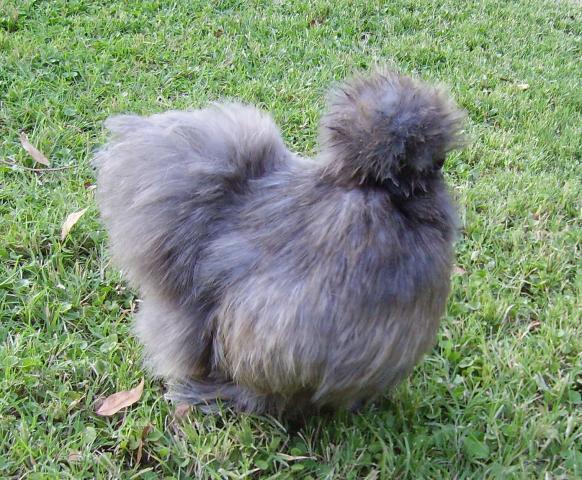Henk69:
I got this all screwed up yesterday.. Didn't I?

Lets try this again.. I was told that the Henny is used to improve/clean up the pattern in females. ( Here is where I screwed up ) A Henny's male offspring will come out henny.
This is what I found in the book (The mating and Breeding of poultry).
Pullet mating-
"Use a hen-feathered male if possible, that is, a male that is as near the exhibition female in markings as possible. Males almost identical in markings to the female are produced and are valuable as breeders if they will fertilize eggs. Often, however,these hen-feathered males will not fertilize. These males have short sickles or no sickles, which increases their resemblance to the females. Use standard colored females for breeding."
Here is something else I found on Hennys at http://jhered.oxfordjournals.org/cgi/content/abstract/75/2/99
Inheritance of the henny-feathering trait of the Sebright bantam chicken
R. G. Somes, Jr., F. W. George, J. Baron, J. F. Noble, and J. D. Wilson
Department of Nutritional Sciences, the University of Connecticut Storrs, CT 06268
Department of Cell Biology, the University of Texas Health Science Center at Dallas, Southwestern Medical School Dallas, TX 75235
Department of Internal Medicine, the University of Texas Health Science at Dallas, Southwestern Medical School Dallas, TX 75235
Please address reprint requests to Dr. F. W. George, Department of Cell Biology, the University of Texas Health Science Center at Dallas, Southwestern Medical School, Dallas TX 75235
Abstract
The henny-feathering trait of the Sebright bantam chicken is the result of an enhanced rate of estrogen synthesis (aromatase activity) in skin and other peripheral tissues of this bird. To gain insight into the underlying nature of this mutation, we examined the inheritance of this trait using a sensitive isotopic assay for aromatase activity. All birds of the F1 generation obtained by crossing homozygous henny X non-henny chickens expressed increased arornatase in the skin, and the males exhibited benny-feathering plumage. The average rate of aromatase activity in the skin of F1 chicks was approximately half that of homozygous henny chicks. The distribution of increased aromatase activity in the F2 generation and in the backcrosses of F1 to the two types of parental strains suggest that the enzyme activity in extragonadal tissues is regulated predominantly by one autosomal gene. Attempts to demonstrate linkage to several known loci by backcrossing F1 heterozygotes with parental chickens carrying a variety of genetic markers were unsuccessful. We conclude that the enhanced estrogen synthesis in extragonadal tissues in chickens carrying this gene is inherited as an autosomal codominant but that a half maximal level of the enzyme is sufflcient to allow full development of female feathering in affected male birds so that benny-feathering is transmitted as a dominant trait.
I am so sorry for the mix up..
Chris
I got this all screwed up yesterday.. Didn't I?

Lets try this again.. I was told that the Henny is used to improve/clean up the pattern in females. ( Here is where I screwed up ) A Henny's male offspring will come out henny.
This is what I found in the book (The mating and Breeding of poultry).
Pullet mating-
"Use a hen-feathered male if possible, that is, a male that is as near the exhibition female in markings as possible. Males almost identical in markings to the female are produced and are valuable as breeders if they will fertilize eggs. Often, however,these hen-feathered males will not fertilize. These males have short sickles or no sickles, which increases their resemblance to the females. Use standard colored females for breeding."
Here is something else I found on Hennys at http://jhered.oxfordjournals.org/cgi/content/abstract/75/2/99
Inheritance of the henny-feathering trait of the Sebright bantam chicken
R. G. Somes, Jr., F. W. George, J. Baron, J. F. Noble, and J. D. Wilson
Department of Nutritional Sciences, the University of Connecticut Storrs, CT 06268
Department of Cell Biology, the University of Texas Health Science Center at Dallas, Southwestern Medical School Dallas, TX 75235
Department of Internal Medicine, the University of Texas Health Science at Dallas, Southwestern Medical School Dallas, TX 75235
Please address reprint requests to Dr. F. W. George, Department of Cell Biology, the University of Texas Health Science Center at Dallas, Southwestern Medical School, Dallas TX 75235
Abstract
The henny-feathering trait of the Sebright bantam chicken is the result of an enhanced rate of estrogen synthesis (aromatase activity) in skin and other peripheral tissues of this bird. To gain insight into the underlying nature of this mutation, we examined the inheritance of this trait using a sensitive isotopic assay for aromatase activity. All birds of the F1 generation obtained by crossing homozygous henny X non-henny chickens expressed increased arornatase in the skin, and the males exhibited benny-feathering plumage. The average rate of aromatase activity in the skin of F1 chicks was approximately half that of homozygous henny chicks. The distribution of increased aromatase activity in the F2 generation and in the backcrosses of F1 to the two types of parental strains suggest that the enzyme activity in extragonadal tissues is regulated predominantly by one autosomal gene. Attempts to demonstrate linkage to several known loci by backcrossing F1 heterozygotes with parental chickens carrying a variety of genetic markers were unsuccessful. We conclude that the enhanced estrogen synthesis in extragonadal tissues in chickens carrying this gene is inherited as an autosomal codominant but that a half maximal level of the enzyme is sufflcient to allow full development of female feathering in affected male birds so that benny-feathering is transmitted as a dominant trait.
I am so sorry for the mix up..
Chris




